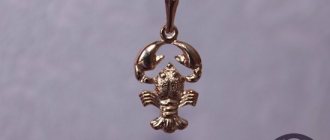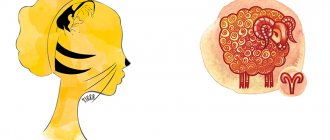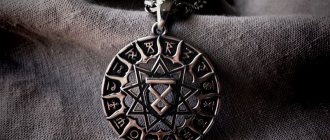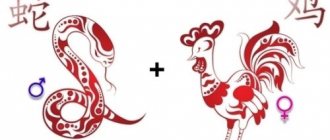The Hall of the Serpent is the fourth sector in the ancient Slavic zodiac system. Lasts from November 27 to December 19, although according to some sources the palace begins already on December 24.
The patron of the Serpent's palace is Semargl (Simargl). A fiery deity, according to legend, who can transform into a winged dog, a fiery bird and even a snake. Read on to learn about the influence Semargl and the Serpent’s palace itself have on their charges.
Origin story
Circle of Svarog.
The Slavs had their own calendar, divided into 16 segments. Each palace of the Circle of Svarog was assigned a totem animal. The snake was one of the most revered animals, because it was considered one of the guises of Fire God, the most important deity in the Slavic pantheon. This reptile was a symbol of wisdom and a source of strong magical energy.
Characteristics and disposition of people
Those who were born in the serpent's palace have a fairly subtle mental organization. It is very easy to hurt the dignity of people of this sign. After all, if they allow a person into their social circle, then they strive to brighten their life with their appearance. They treat their loved ones very kindly and do not tolerate betrayal. But if this happens, the representatives of the sign turn away from the offender forever.
The ability to sense the mood of the interlocutor in time saves people from the serpent’s palace and avoid possible conflict situations. But if the need arises to defend their interests, then the snakes do not retreat until they achieve what they want. Among the main character traits of the representatives of the palace are the following:
- Vivid egoism;
- Fear of loneliness;
- Sociability;
- Sensuality;
- Passion for activism;
- Flexible mind;
- Touchiness;
Representatives of the serpent's palace have a craving for exact sciences. They have very well developed logic and memory. In addition, they have a cold mind, which does not allow them to be fooled. However, such people perceive criticism negatively. They can flare up if they hear a negative statement addressed to them.
Despite their desire to learn a lot, snakes are true conservatives. They find it difficult to accept innovations. It is noteworthy that this sign of the palace is attractive, despite some shortcomings.
Description of the Serpent's Palace
The Hall of the Serpent is the fourth house of the sacred Slavic Circle of Svarog. He has a special patron god, a totem animal and a sacred tree.
Appearance of the symbol (rune)
The Snake sign consists of 2 elements: the rune of Strength (looks like a thick horizontal line) and the Slavic swastika with rings on all 4 ends. Often on amulets the symbol is enclosed in a nine-pointed star or the Circle of Svarog (it is believed that this enhances the energy of the amulet).
Amulet made of sacred wood.
Patron
The patron of the palace is Semargl - the god of fire and sun. According to mythology, he emerged from the flames of the sun. This god occupied an important place in the Slavic pantheon.
With his fiery sword he drove away evil spirits, dealt with demons, and protected people. If necessary, the Fire God can transform into animals, including a snake and a wolf.
Its flame was believed to melt ice and snow at the end of winter, preparing fields for sowing. With fire, Semargl is able to expel any disease from the human body. This god was one of the few who lived on earth with people.
He was revered as a strong, but wise and prudent warrior, able to solve problems and end wars without bloodshed.
sacred tree
The sacred tree of the Snake is the linden. This plant symbolizes longevity, purity and family happiness. The Slavs believed that the linden tree is a loving mother, giving every person joy and spiritual enlightenment.
The color of the plant was used medicinally to treat colds. Wood amulets were used when a person had to make a difficult decision. They carried bags of dried leaves with them to protect them from the evil eye and bad thoughts of others.
Linden is a sacred tree.
Semargl - patron god of the palace
The Hall of the Serpent has a divine patron - the Slavic God of Fire. According to some sources, Semargl was the Guardian of Crops.
One of the legends explains why Semargl was so important to the ancient Slavs. It was believed that it was this god who burned the snow in the fields, “opening” the land for sowing.
In a sense, the meaning of this deity echoes the meaning of the Solar God. Semargl had a fiery sword in his hands, with which he dispersed all evil spirits crawling into the human world from Navi. That is, the veiled meaning of the Sun can be traced.
Semargl is the patron of the Serpent's palace.
What Semargl gives to those he protects:
- The Fire God gives the people of the Serpent's palace a feeling of well-being, because fire, as they used to believe, can overcome any illness. When using a talisman for this purpose, one cannot ignore the advice of experts about cleaning. Without special rituals, the amulet will quickly stop working.
- A talisman with a deity protects against any evil - spirits and other evil spirits, damage or the evil eye.
- Saves from hunger - the house of a family that has the Semargl amulet will always be full of food. This interpretation also hides a figurative meaning - thanks to the amulet, the family will become rich on a spiritual level.
Like many deities of the Slavs, Semargl is a warrior. But the warrior is wise. In Rus', the ability to resolve conflicts without the use of weapons was valued. Semargl patronizes scientists and speakers.
The amulet with the Fire God will be useful to everyone who wants to gain new knowledge. Not only for schoolchildren and students, but for anyone in general. It will bring good luck and help you get comfortable in an unfamiliar topic.
Energy vortexes of the Serpent's palace and its impact on humans
The most important in the Snake’s body are the 3 Navi vortices, the functioning of which is responsible for human health and well-being. These energy centers are the hardest to work with, because... Removing blocks is often accompanied by physical pain.
But only after bringing the body into balance can you move on to psychological treatment and spiritual enlightenment.
The Mother's first energy center is located in the soles of her feet. Working on it helps improve the functioning of internal organs, relieve stress, and normalize sleep.
The second center, Source, is localized in the perineal area. He is responsible for strength of character, assertiveness, and the ability to behave in conflict situations.
The most important for the Serpent is the third vortex of Horus, located in the pelvis, slightly above the pubic bone. This energy center promotes a healthy attitude towards love and sex, helps increase self-esteem and improves communication skills.
Simargl - keeper of the eternal Fire
Simargl is the highest deity, commands fire. His main mission is to ensure that people strictly observe all fire rituals and purifications.
The ancestors, in order to appease this god and beg him for forgiveness for their sins, made sacrifices. They must be bloodless.
Simargl is also a mediator between mortal people and gods. He is a human protector. The deity is kind and merciful to those who fulfill all the commandments and do not anger him.
The ancestors turned to Simargl to heal a person or animal. This god has the power to improve health and save any creature from suffering. When you get sick, pray to Simargl:
After prayer, the patient was taken to the bathhouse - they believed that the heat would cleanse and relieve ailments.
Character traits
Snakes are active people who are always on the move. Their lives are clearly organized, they rarely make mistakes and they know exactly when and what goal they are going to achieve.
But representatives of this sign are prone to narcissism and often forget about the needs of others. For such people, only their own point of view is important (they will listen to their interlocutor only for the sake of benefit or if he interests them).
Snakes do not react well to criticism, especially if it was expressed publicly, but they love undisguised flattery.
In men
A Snake man is easy to recognize by his characteristic features.
- Representatives of this sign can often be seen in the gym. Physical activity helps clear the mind of unnecessary thoughts, concentrate, and raise morale.
- Snakes are strong and purposeful. If they want something, then it’s unlikely that anything can stop them on the path to their dream. But the men of this palace are also sane. They do not take unnecessary risks, think through everything to the smallest detail, rarely make mistakes and get into trouble.
- Snakes make good diplomats and leaders. They are always ready to listen and accept someone else's point of view.
- Representatives of this palace put all their strength, energy and capabilities into their work, which allows them to occupy high positions.
- Snakes quickly fall in love and create strong families. Sometimes men can be too reserved and taciturn, but they always remember the needs and desires of their woman. They do not like intrigue, scandals and emotional scenes, preferring stable, calm relationships.
Snake Man in the gym.
Among women
Snake women know how to attract the attention of others. They know how to highlight their natural attractiveness with subtle makeup and elegant clothing.
But in addition to their beautiful appearance, the girls of this palace also have special character traits.
- Women have developed intuition. During a conversation, they can almost accurately determine what the interlocutor is feeling and what he is lying about. Snakes are talented manipulators, and they often use this ability for profit.
- Although the girls of this palace look arrogant and strict, they are kind and sensitive, endowed with feminine softness.
- In a relationship, they give everything without reserve, but they expect the same from their partner. If a man is unable to provide what he wants, the girl will leave the relationship without hesitation.
- Women's careers are going well. Representatives of the palace are versed in the exact sciences and languages - it is difficult to find a profession that the Snake could not master.
World interpretation of the unity of contradictions
Many peoples proudly reported in fairy tales, chronicles, and religious texts that they descended from a certain Serpent (snake).
- The original Americans had a powerful winged protector - Quetzalcoatl;
- The ancient Greeks had the Caduceus, a staff entwined with snakes, which was considered a symbol of the universe;
- According to Hindu myths, the snake Ananta helped Vishnu create the world - served as his support during the difficult process of creation, and the Egyptian snake-headed Renenutet was responsible for fertility;
- And it is no coincidence that the pharaohs wore ritual dresses with snake heads - this gave them wisdom that helped them communicate with the gods.
Symbol of death and rebirth
The execution is different, but the meaning is the same, the meaning of the “snake” amulet is the same. This is a combination of death and rebirth, that cycle from which, in fact, all things arise. Suffice it to remember about Ouroboros - a round symbol in the form of a reptile that grabs its tail with its teeth. Under one name or another, this sign of eternity appears almost at the same time among different peoples. This is both the heavenly egg, from which our Universe was born, and the karmic wheel of samsara.
Today, such symbolism is again becoming popular and in demand (which simply once again proves the “circular nature” of the universe and worldview).
- The “three snakes” amulet, for example, is used to awaken one’s own hidden potential – especially in the field of creativity.
- A special ornament on clothing serves to protect against evil forces.
- Jewelry acts as amulets, helping the owner to overcome obstacles and defeat enemies with the help of wisdom.
As we know, the snake can often be seen in the symbolism of different countries, peoples, religions and times. It had the most meaning at the beginning of human civilization, in the Ancient World. In his myths you can often find a “mighty serpent”. He is worshiped, sacrifices are made, he is very large and long (from 30 to 140 cubits), he is the ruler of a certain territory (prince or king), which we can see in the legends of the snake islands. Our ancestors were also very impressed by the ability of snakes to shed their skin. Now we are talking about the “immortal serpent,” which means immortality, eternal youth and resurrection, renewal. But here we can also trace the duality of the nature of the symbolism of the snake, since the deadly poison contained in it can also mean death and fear. Let’s not forget about the “wise serpent,” let’s remember at least the most common symbol of medicine: a snake bent over a bowl, which is still used today. But, let's plunge into religion: in Christianity, a creeping reptile means temptation. Kundalini is the vital energy located at the base of the spine, I call it “snake power”, it is depicted in the form of a snake ball. According to legend, precious stones are the frozen saliva of a reptile. Do not forget about the negative meaning among sorcerers and witches - parts of the animal are used in potions. And finally, another eternal symbol: a snake biting its own tail, a symbol of the eternity of existence, time and the cyclical nature of natural phenomena. A snake protecting its eggs looks fascinating. The egg in this case is associated with the Earth, our world, it seems to support and help it. In Africa, you can find many totems with the image of a reptile. There is a belief that long-dead ancestors are embodied in them. Already. This harmless snake is often mentioned in European countries at a time when it was still considered poisonous. Due to the fact that snakes often settled in houses, a belief arose that they protected them from enemies. The cobra is one of the more dangerous manifestations of the "mighty serpent", especially when it is in its "fighting stance". In India, cobra nagas are sacred symbols of protection. It was the cobra with its hood that protected the Buddha, exhausted on a long journey, from the scorching rays of the sun. Also, a cobra with precious stones on the hood can mean spiritual values. The Viper appears in symbolism as a negative hero. She is credited with deceit, sin and evil. Python is more related to the water element. It is also attributed a phallic meaning - it is a symbol of male potency.
The power and meaning of the amulet
An amulet with the image of a symbol has pronounced magical properties:
- The talisman enhances determination and perseverance, improves communication skills, and increases performance.
- The Snake sign will gradually smooth out character flaws. A person will begin to pay more attention to others, listen to them, and avoid conflicts.
- The amulet creates a shield around its owner, through which black magic cannot penetrate. Runes also protect against internal negativity. They help cope with disappointment and depression, and continue to work during emotionally and financially difficult periods.
- The Snake amulet will protect your love too. It will help preserve romantic feelings for a long time, turn a light hobby into a happy family union.
Magical properties of the amulet
The magical and protective talisman is made in the form of crossed triangles, which are included in a circle. In the center is the symbol of a snake.
According to Slavic mythology, the amulet of the Serpent helps to neutralize negative character traits in a person. With the help of such an amulet you can easily get rid of impulsiveness and touchiness. The talisman will help you establish relationships with others and achieve success in any field.
The Slavic amulet will not only protect you from committing rash acts, but will also help maintain trusting relationships in the family. With its help, it is easier for husband and wife to develop trusting relationships between themselves. If there are children in the family, thanks to the amulet, parents will easily find an approach to them.
In difficult moments, a person experiences feelings of anxiety, apathy and depression. With the help of the Serpent's palace, all these sensations will disappear: a person will quickly acclimatize to an unpleasant situation and solve the problem that has arisen.
Snake tattoo
A tattoo depicting the symbol of the palace allows its owner to discover hidden talents. Runes will ensure rapid intellectual development and success in any business.
But only emotionally stable people with a powerful aura can apply a design to their skin. The constant proximity of the amulet sometimes enhances qualities such as temper, aggressiveness, as a result of which a person will constantly create conflicts around himself.
Old Slavic amulets.
How to choose an amulet
The talisman can be made of wood (in this case, it is better to use linden wood as a raw material, which will enhance the magical effect of the Snake symbol).
This amulet is suitable for those representatives of the palace who are faced with physical weakness and emotional exhaustion.
Silver, which is combined with this house of the Svarog Circle, is also suitable. Silver jewelry is recommended for people to wear to protect them from energy vampires.
It is not recommended to accept an amulet as a gift from a person who is not a close relative (parents, children or spouses can give the amulet). If you buy a product, it is better to hold it in your hand for a few minutes - if you feel a surge of calm, then the talisman is suitable for you.
Characteristics of one of the parts of the sacred ancient Slavic circle
Let's consider what the Hall of the Bear means. People who were destined to be born between the seventh and thirty-first of January are under the protection of one of the most powerful Slavic gods - Svarog. By nature they are very kind and peaceful. However, this does not prevent them from having some impulsiveness in matters of feelings. Sometimes their hidden explosive potential is revealed in words and deeds. Sometimes it is impossible to guess what to expect from a person born in the Hall of the Bear. Having become the head of the family, he will do everything possible to ensure that his family prospers and is happy. “Bears” have the gift of finding a way out of various, sometimes very serious and difficult situations. It was believed that the sacred plant of a person born during this period was raspberry.
Rules for using the amulet
It is better to wear the talisman closer to the body (so that it touches the skin). It is not recommended to lend it to other people or allow them to touch the amulet - it is better to hide the product from the eyes of others under clothing.
After purchasing the amulet, it must be cleared of the energy that it has accumulated. It is better to do this with fire. On the day of the ritual, you should fast and maintain good spirits.
At night you need to take a shower and change into clean clothes. The Slavs purified talismans by lighting fires. But if you do not have such an opportunity, then a candle will do - you need to hold your amulet over its flame for several minutes.
After this, it is recommended to activate the amulet and charge it with pure energy. For this purpose, you can use fire, wind, and spring water. Other options: bury the talisman in the ground and leave it there overnight or cover it with sea salt.
Semargl and Simurghi
In very ancient times, the ancestors of the Slavs, the Sarmatians, called the warrior god Simurgh, who they associated with the eagle...
In books about Zarathustra, whose time is considered to be the middle of the first millennium BC, Simurgh is often mentioned - a shining bird (translated from the language of the Avesta) or, in our opinion, the Firebird. Moreover, later, in Persian fairy tales and in Persian poems of the 12th century, for example, by Khakani, Russians are called Simurghs”...
Historians ask the question: what is the point of calling a neighboring people after their deity? Or is this an admission that the cult of the Simurgh was borrowed from the Russians? “...After all, one of the main gods of the Kyiv pantheon was Semargl (Simargl) - Simurgh, and the rituals dedicated to him were associated with lighting a fire...”.
It’s even easier to connect the name Semargl not only with the Iranian word “marega”, meaning bird, but also with the Russian numeral “seven”. If the name of the ancient Russian seven-headed god Semargl came from the Indo-European “sedm”, then the ancient Iranian Simorgh may have come from the word “seven”, which did not originate in Iran, or from Semargl! By the way, the number “seven” today among Iranians is “gaft”, in Bukharian “aft”. “Gaft” is the Iranian name for seven, which is considered known since the 8th century, although on Iranian astrolabes Iranian numbers begin to appear only in the 17th century, and before that all the numbers there were Old Arabic. According to Arabic Abjad, seven is “zayn”. And from the Avestan name of Simurg - “Saena”, it seems, it is very close not only to the ancient Indian “Shyena”, who stole the divine drink soma from the gods, but also to the Sayan Mountains... It is sometimes mentioned that not only the name of the seven-headed god Semargl came from the Indo-European “sedma” ", but Semargl himself was considered the personification of the entire seven Russian pagan gods (six gods were in the pantheon of Prince Vladimir, who is the seventh?).
| Semargl in Chernigov. XI-XII centuries AD |
In medieval Rus', letters were used to designate numbers, and the number seven was denoted by the letter “З” (“earth”). And in Russian paganism there is a goddess Simargl - Zimargla, which is distantly consonant with both Semargl and “Earth”, which meant winter, frost and a crown of ice…. Mythologists of the 18th century tried to turn this “goddess Simarglu” into “Zimtserla,” the goddess of spring and dawn. And at times, among ancient Russian scribes, his name was divided into two gods Shem and Regla; back in the 11th century, in the work of “a certain lover of Christ and a zealot for the right faith”, “Sim and Regla, to whom not only the ignorant, but also priests and scribes pray.” You can also find images of Regla in the form of a “river corcodile lizard”. However, it turns out that the “lover of Christ” who wrote about him in the 11th century knew nothing about the god Semargl, whose idol had recently been erected and overthrown, along with other Slavic pagan gods, by Prince Vladimir in Kyiv.
In the book by A.I. Asov “Ruskolan - ancient Rus'” there is a medal with the image of the god Semargl in human form. Near Semargl there is a golden-maned horse with silver wool. It also mentions his relationship not only with the Iranian Simurgh, but also with the ancient Greek Prometheus.










